AI and Education
Coversation about how Artificial Intelligence will influence education and teaching
A few weeks ago I had a conversation on Facebook about AI, like I normally do, and found a person who disagreed with me. but I immediately sensed that Shlomi knew what he was talking about. So, I invited him for a longer discussion about the future of artificial intelligence, or better - the future of human society.
“AI will get closer to the human brain. And sooner than we imagine.” Shlomi Nuefeld
We found that although we started from different worlds, Shlomi comes with 20 years in the traditional education system, while I am coming from game development - both of us ended up doing similar tasks today and striving towards the same goals: teaching the teachers how to wisely use emergent technology in the classroom.
We spoke about various use cases of AI, what is so special about it, the risks, the future influence on the job market, but our main focus was on the educational field. How can teachers and educators benefit from the possibilities with AI tools.
“AI helps us to create content, understand content, and evaluate it” Shlomi Neufeld
We spoke about the future of society, and the job market in a world where AI works better. We reviewed the possible changes to some industries, and clarified our disagreement. While Shlomi thinks that AI might be able to completely replace some jobs, I believe that we would need a human in the loop for quite some time.
I also believe that society should have the choice in the matter. Humans should have a choice whether they want the machines or not, as we can always unplug their electricity. But to know this, we all need to explore this world, to understand the benefit and the danger.
“AI can assist us to do the job, but we disagree about the possibility that AI will be able to actually do our job” Shachar Oz
AI Use cases mentioned
Human resources and job search. Writing a resume; rewriting a resume for a dedicated role; writing a cover letter; evaluating a resume for a specific position.
Presentations, writing and reading. Writing essays, articles, and blog posts; understanding and evaluating the content of essays, articles, and blog posts.
Programming and coding. Code assistant; writing small-scale functions; writing applications that are 100% code-based.
Translation. Writing text in various languages; set writing style.
Personal assistant. Writing emails;
“When the goal is clear and well defined, it can be achieved with AI tool” Shachar Oz
AI Tools mentioned
Wordtune
Grammarly
Our conversation
Terms mentioned
AI or artificial intelligence: a piece of software that can receive input and provide a response, while a software engineer is not able to understand the reasoning that the system made to reach that response. This is different than an Algorithm, where the engineer can predict exactly what would be a response for any input that would be given.
Generative AI: an AI model, more professionally called Large Language Model (LLM), which can receive text as an input, and generate text as feedback.
Machine learning: the core technology which help software developers to create an AI model.
Computer vision: AI model that allows the machine to interpret visual information from cameras or other sensors.
Emotional recognition: AI model that allows the machine to interpret visual and audial information and detect the emotional state of a person.
Image generator: AI model that provides an image as a feedback to text prompt.
Prompt engineering: the ability to provide an input to the machine that will result in more expected outcomes.
Questions that remained open
What about privacy? How do AI tool use the information we provide to them in our chat with them?
How does AI really work? How do they actually build a new AI model?
When will someone be able to build a Human-brain level AI model?
Recommendations
Try it by yourself to understand what its all about. Give yourself the time to explore.
Define a task that you know you can perform by yourself, and work with the tool to make it. Check the difference in time and effort.
Define a task that you do not know how to perform. Try to accomplish it with the tool.
Consider working in a group of people about a single task. This can also become a class activity.
We hope we assisted and inspired others to explore the advantages and the risks.




